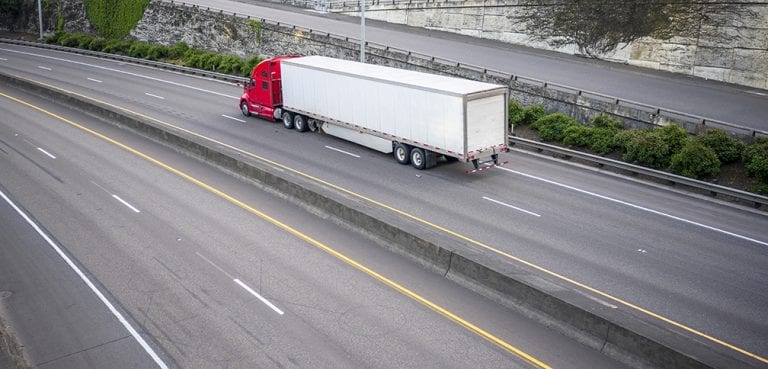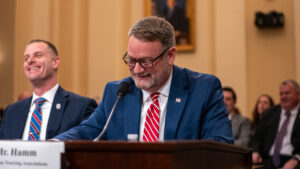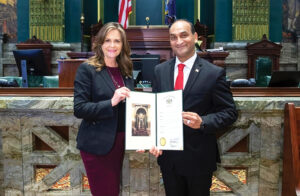COLLEGE PARK, Md. — Road user charge pilot programs are being implemented by state department of transportations across the nation. However, none specifically focus on what a road user charge program, more commonly known as a vehicle miles traveled (VMT) tax, would mean for trucks.
Formerly known as the I-95 Corridor Coalition, the Eastern Transportation Coalition (TETC) has sought to change that. While the TETC has evaluated passenger vehicles in a road user charge system, the coalition has made a point to focus on tractor-trailers.
“There really hasn’t been enough attention really focused on the trucking industry as we’re looking at a way to fund transportation,” said Trish Hendren, executive director of TETC. “That is of concern to the coalition. We’ve been working with the coalition throughout our 25-year history, and we understand that it’s a very complex, very diverse and heavily regulated industry that faces a lot of fees. We understand the complicated operating environment in which truckers exist, and we were concerned that those unique attributes of the trucking industry were not a part of this national discussion of how we pay for transportation in the future.”
So far, the coalition has conducted two mileage-based user fee (MBUF) studies, one in 2018-19 and another in 2020-21.
While the coalition is still awaiting results and data from the second pilot program, the first showed key findings that an MBUF still requires more research before implementation.
The first truck pilot consisted of 55 trucks that traveled more than 1,430,000 miles across 27 states during the six-month program period.
The technology used was in collaboration with EROAD, a fleet management and tracking systems research partner, to create an in-vehicle device to compile MBUF data, as well as record hours of service (HOS), the electronic logging device (ELD), the International Fuel Taxation Agreement (IFTA) and record keeping.
Although the technology has the capability to track all of those, it could also be a separate device from other traditional forms of ELDs, according to Hendren.
“The work is not designed to say that EROAD has the technology answer,” Hendren said. “There’s going to be a range of providers, and that’s the way it needs to be. But we wanted to partner with an actual technology provider so we could get that real-world information. You either use existing devices and data within the truck, or you have additional hardware that is installed temporarily for the pilot.”
The on-board unit (OBU), called Ehubo, uses sensors to track the distance the vehicle travels, locations and route, including a global positioning system (GPS).
The rates per-mile in an MBUF system had to take in account a range of average fuel efficiencies, how far a truck can travel on a gallon of diesel and states’ diesel taxes. For the pilot, TETC used an average of 6 miles per gallon (mpg).
The per-mile rates were designed to be “revenue neutral,” meaning that a truck achieving the national average mpg would pay the same amount of fees as paid in state diesel tax, according to TETC’s final report on the first pilot program.
However, TETC found that an actual per-mile tax rate in an MBUF system would need to vary based on the type, age and typical operating weight of trucks as well as the mileage traveled.
“If you have an average value, you’re going to punish your fuel-efficient companies that are invested in fuel-efficient trucks, and you’re going to reward your fuel-inefficient trucks,” she said.
A national average mpg generates rebates for fuel-inefficient vehicles, while fuel-efficient fleets would be required to pay penalties.
“I think one thing that was exciting to me when we started this pilot … is the responsiveness of having the (trucking) industry at the table,” said Marygrace Parker, director of the freight program. “The industry being able to say, ‘We’re not all the same’ — even in talking about size and weight they run for the hills, but they recognize that we do need to think about classification settings; how do we do that and how do we make it amongst ourselves, because it’s very complex.”
From the first pilot, five key points were found:
- Bringing the trucking industry’s voice to the table is essential.
- Trucks cannot simply be treated as big cars in an MBUF system.
- Existing regulations provide guidance for MBUF implementation.
- One rate for all trucks does not work.
- There is a further need for education and outreach.
Further research includes analyzing the rate-settings by developing per-mile rates for each state, taking into account weight variables for trucks, tolling systems and improving operations of the pilot.
Within future studies, Hendren said setting up enforcement and compliance of MBUF would also be a goal for the coalition.
“There is just a need to not treat cars and trucks the same,” she said. “If we move in this direction, everyone should do it. It shouldn’t be just one or two companies that follow the rules, so how do we as an industry set up enforcement and compliance in a way that is not burdensome? So, (we’re) talking to them about making it fair across the industry and making it set up in a way that is easy to fulfill.”
The mileage-based user fee research is funded by the Surface Transportation System Funding Alternative (STSFA) under the Fixing America’s Surface Transportation (FAST) Act, authorized by former President Barack Obama in 2015. STSFA provided grants to research and test the design of user-based alternative revenue mechanisms to maintain the solvency of the Highway Trust Fund (HTF).
The HTF provides funding for highways through a federal fuel tax, which is 18.4 cents per gallon on gasoline and 24.4 cents on diesel. The tax has not been increased since 1993 and has been primarily funded through a series of transfers, according to the Congressional Research Service.
As it stands now, the HTF will be exhausted by 2022. TETC, along with a handful of departments of transportations, were granted STSFA funding to create pilot programs of road user charge systems.
“Truckload Carriers Association (TCA) is pleased to see that the Eastern Transportation Coalition’s new study has produced much-needed multistate data on the viability of a mileage-based user fee (MBUF) for the trucking industry,” said John Lyboldt, president of TCA. “This study is a good first step, and we agree with the coalition’s report that additional data is still needed before any nationwide policy on MBUF can be pursued. We hope that the coalition’s work will provide a signal to federal policymakers that it is premature to start transitioning to a new revenue collection model and that significant questions must be addressed regarding MBUF implementation, especially for the trucking industry, before moving forward.”
Hannah Butler is a lover of interesting people, places, photos and the written word. Butler is a former community newspaper reporter and editor for Arkansas Tech University’s student newspaper. Butler is currently finishing up her undergraduate print journalism degree and hopes to pursue higher education. Her work has been featured in at least nine different publications.














